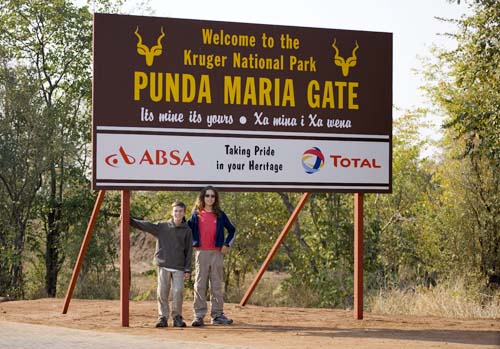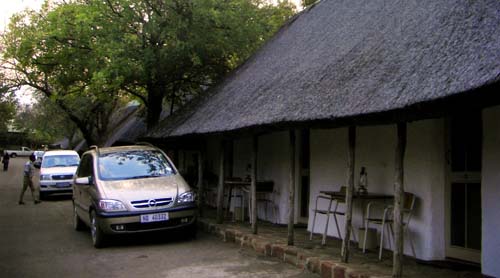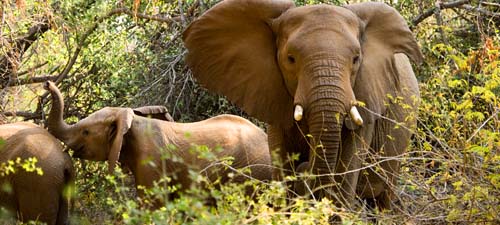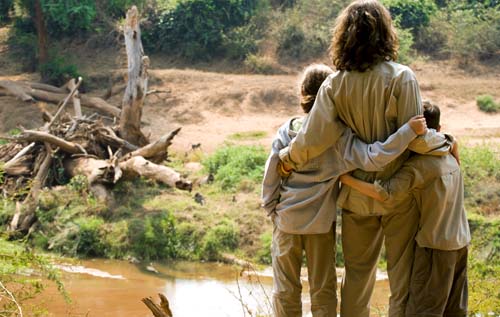Kruger – The North
We entered the Punda Maria gate before 9am. After a smooth entry through the park service personnel we were in. We were instantly rewarded with warthog running down the middle of the road! A few minutes later we had zebra. Impala were everywhere. Wow.

Our first two nights were based at the Punda Maria lodge, the northernmost such accommodation. This is a human zoo within the park, as we were the ones inside of fences. The lodge is surrounded by a large fence to keep out most animals, which in turn has steel cable to keep out elephants and larger animals, and is electrified to keep out anything that doesn’t get clued in with the first two defenses. We were the ones looking out this time. The gates to the lodge open at 6am and close at 6pm (just about dawn and dusk). If you do not get back before the gates close you are fined about $450. Ouch. Motivation enough to make it back on time.

The lodge is a collection of double occupancy traditional huts, all without keys. Some of which have been in continuous use for over 100 years. This is camp on an old trading route from the coast of Mozambique and the cities further inland. It was created by a European explorer who crossed the name Punda Marie, which in the local language meant ‘many zebra’ and his wife’s name Maria to get Punda Maria. The whole place, though not very large, is built on the side of a tall hill to give it some vertical separation to the surrounding valley.
We had two rooms here, side by side. Each had thatched roofs that are very beautiful. The roofs are made with about eighteen inches of reed grass. Inside you can see the under side of the reed roof, which gives the entire room a very warm and exotic look.
Even with the fences we had a huge family of Vervet Monkey’s living with us. We had to be careful as they have a tendency to steal your picnic if you leave it at all exposed. An issue we would have later in the week.
After checking in early, we bought a local park map (in Afrikaans since the English version was sold out), found where the closest drive route was and headed out. This entire week was self driven. We did not have guides or rangers with us. In some places we were more than 50 miles from help. If we encountered car trouble, got stuck on a dirt road, or were hurt from a charging elephant we were on our own. No, there is no cell phone coverage out there. As daunting as that sounds, we never felt it to be so.
The act of viewing animals on safari is not unlike that of fishing. You generally know where the fish are, but you still have to wait and there is luck involved in catching one. There was no skill, as we were not up to spending $2,000 per night so we had an army of rangers connected by radios who were all out scouting every corner of the park continuously so that we could see everything in one day and get back in time for a massage, cocktail, five star dinner and $100 bottle of wine. (Not that we would turn that down if we could afford it, mind you.)
The first drive was a 15-mile loop around the mountain that the lodge was situated on. We quickly started seeing animals and began what we later learned to be a classic new-comer approach to viewing animals. The first day you see impala and you just sit there and shoot a million pictures and marvel at them. The next day you see impala and slow down and take a few pictures. The next you slow down and look. The trend continues until you swear under your breath at the damn impala that keep getting in your way to bigger and better game. Now go back and replace impala with elephant, giraffe, wart hog, etc. By the end you are so focused on finding what you haven’t seen that you don’t have time to marvel at what is already in front of you. The human mind is amazing and maddening at the same time.
Our first elephant was magical. We were all in awe. African elephants are much larger than their Asian cousins (which we are accustomed to from our times in Thailand) and as long as there are no babies amongst them, they are approachable. We spent almost an hour just watching the same elephant. We also came across a giraffe mom and baby. Unlike elephants, they aren’t too worried about our presence when they have young ones. On the contrary they are almost always very curious about you and often you end up in a staring contest.

We returned before the gates were closed and slept well. We were all up at 5:15am and out the gate at 6am to make the same loop once again. Animals are much more active at dawn and dusk so we were very excited to see more game during this time. It was a bust. We did not see anything of note. Back to the lodge early, a bit disappointed, we had some breakfast and headed out again.
No more than fifteen minutes into our second drive of the day and we ran into an entire herd of male elephants. They were slowly moving along the dirt road we were on as they ate and generally destroyed every other tree in their path. It is amazing how much destruction these huge animals create. They can snap a twelve-inch tree at the base with little effort, though they normally seem to just snap off branches within trees. What appears to be a scorched earth sort of eating habit actually serves the food chain. Many animals who depend on the same food as the elephants can’t break trees like they can. So the left over broken branches and leaves, which there is many, are now available for smaller animals. The footprints the elephants make with their weight opens the earth and exposes insects for birds to eat. Elephants only digest forty percent of their food, so their dung is full of viable food, which of course is eaten by other animals, so on and so forth. Who knew elephant poop was so important, and so plentiful! They are like landmines on every inch of the roads. Don’t hit one you could blow a tire (and the smell isn’t pleasant either).
We took over 500 pictures of this elephant herd alone. We also ran into two giraffe about five minutes after leaving the elephants. Thereafter, we hit an asphalt road and headed about forty minutes north to a picnic area on the Luvuvhu River just south of the Zimbabwe border for lunch. Being new to the park we figured the picnic areas would be just like the lodges with serious fencing around to protect us. Around the most of the park, there are numerous signs and notices not to get out of your car. The stories of people ignoring such warnings and getting eaten are numerous and a number of people lose their lives every year from being eaten by predators. So when we arrived at the picnic ground and found no fences we were concerned. A sign said essentially that you could get out of your car and have lunch at your own risk. Gee, thanks!
After the initial fear and butterflies subsided and we settled with the feeling that we were only playing with fire we sat down to eat our peanut butter and jelly sandwiches, drink our warm water and enjoy some soft melted cheese on two day old baguette. It was a great lunch. I took a great image of the family on the banks of the Luvuvhu River as a huge baboon family came to the river to drink and move on. After lunch a Kudu mom and her baby walked by us. The whole picnic ground was shaded by huge trees that must have been at least 100 feet tall. What a special place.

With full bellies, relieved bladders and stretched legs, we headed a few miles to the east to find Crooks Corner. This is the point where South Africa, Zimbabwe and Mozambique all meet. So called because it looks out onto the Lumpopo River (popular with elephants) and poachers would sit here to kill elephants for the ivory trade. There were no poachers when we arrived and there was no water in the river either. It hasn’t rained here in nine months and the river, which must have been almost a mile wide, was dry. Amazing.
With a number of miles to drive back to our lodge, we headed back. Overall a successful first two days in the far northern parts of Kruger. We are still in search of the lion. Calls for Mufasa went unreturned. Tomorrow is another day.
Tags: Elephant, Kruger, Photography, Safari, South Africa, Travel

Leave a Reply